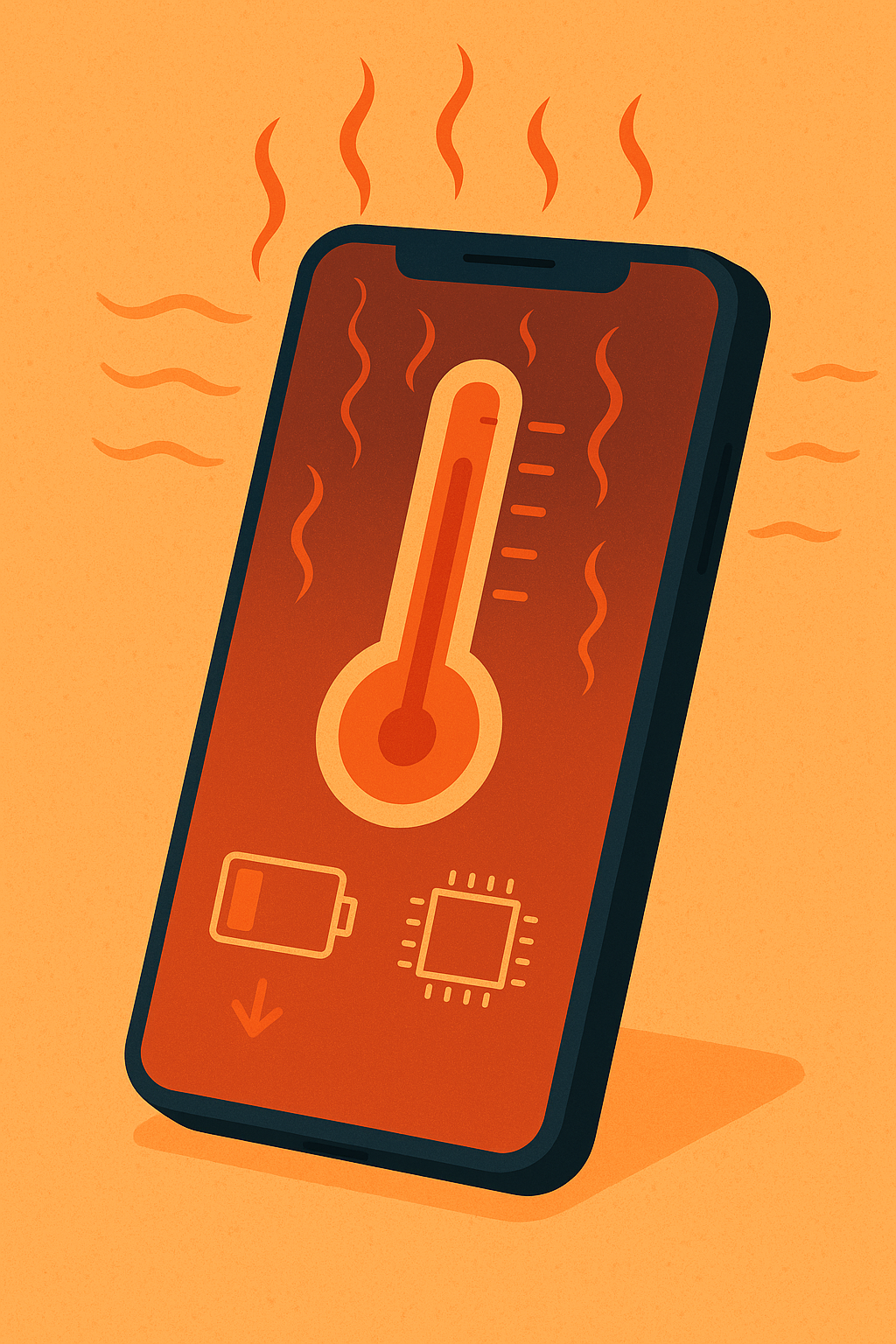Written by:James Whitaker

Ever wondered why your phone suddenly slows down during gaming or heavy use? The hidden culprit might be thermal throttling — a built-in safety feature that keeps your smartphone from overheating but also quietly cuts your performance.
At Mobile Fix Experts, we see countless phones brought in for “slow performance,” when in reality, the problem often lies deep in how the device manages heat. This guide breaks down what thermal throttling really is, how it affects your daily experience, and what you can do to manage it effectively.
Section 1: What Is Thermal Throttling and Why It Exists
The Science Behind Smartphone Heat
Every phone generates heat while working. Processors, graphics chips, and batteries all produce warmth when they perform demanding tasks — like running multiple apps, gaming, or streaming high-definition video.
When this heat builds up beyond safe levels, your phone automatically reduces performance to protect its internal components — a process called thermal throttling.
Why Manufacturers Include Thermal Throttling
Thermal throttling isn’t a flaw. It’s an intelligent safeguard designed to prevent permanent hardware damage. By reducing the CPU’s clock speed, the device lowers its temperature, ensuring the internal parts last longer.
However, frequent throttling can become a serious nuisance — especially if it occurs even during light usage.
Section 2: Recognizing the Signs of Thermal Throttling
- Sudden Lag During Games or Videos
Your frame rate drops and graphics stutter after a few minutes of gameplay. - App Freezing and Slow Loading
Apps that used to open instantly now take several seconds. - Rapid Battery Drain
The phone warms up and loses charge faster because the processor keeps working under strain. - Device Feels Hot to Touch
Prolonged warmth around the back panel or near the camera module signals excessive heat buildup. - Automatic Brightness Reduction
Many phones dim the display automatically as part of their thermal control.
If you’re facing any of these symptoms, a visit to Repair a Device might be due — technicians can run diagnostics to confirm whether throttling or other hardware issues are responsible.
Section 3: Common Causes of Overheating and Throttling
1. Heavy App Usage
Running multiple background apps strains both RAM and CPU. The phone attempts to cool itself by slowing operations.
2. Outdated Software
Old operating systems lack the efficiency improvements of newer versions, causing your processor to work harder.
3. Poor Ventilation
Using your phone under a pillow, in direct sunlight, or inside thick cases traps heat.
4. Charging While Using
Gaming or streaming while charging adds extra load on the battery and processor — doubling the heat output.
5. Hardware Dust and Aging
Internal dust, debris, or degraded thermal paste can trap heat inside the device, accelerating throttling.
Our team at Mobile Fix Experts recommends periodic cleaning and professional maintenance to prevent long-term thermal stress.
Section 4: How Thermal Throttling Affects Your Phone Over Time
Reduced Performance
Your phone might seem slower not because it’s old, but because it has learned to self-limit its performance to avoid overheating.
Shorter Battery Lifespan
Constant heat degrades lithium-ion cells faster, leading to reduced battery health and capacity.
Component Damage
Prolonged overheating can warp internal circuits, loosen solder points, and affect the logic board — leading to costly repairs.
Inconsistent User Experience
One day it’s smooth, the next it’s sluggish — unpredictable throttling creates inconsistency in performance.
When this becomes frequent, consider visiting Repair a Device for a diagnostic check or battery replacement.
Section 5: Practical Ways to Reduce Thermal Throttling
1. Avoid Heavy Multitasking
Close unused apps from the background. This instantly lowers CPU demand and internal heat.
2. Keep Your Software Updated
Firmware updates often include thermal optimization patches to manage performance better.
3. Remove Thick or Insulating Cases
Bulky cases trap heat. Use lighter, ventilated designs — especially during gaming sessions.
4. Use Battery Saver or Performance Modes
Most modern phones let you control CPU intensity. Enable balanced modes to avoid overheating.
5. Don’t Charge While Using
Let your phone rest during charging sessions to prevent overlapping heat sources.
6. Clean Dust and Debris
Professional internal cleaning from Mobile Fix Experts can remove dust blocking airflow and improve thermal conductivity.
7. Replace Aging Batteries
An aging battery generates more heat. Visit Repair a Device for reliable replacements.
Section 6: When Thermal Throttling Signals a Deeper Problem
Sometimes, throttling is only a symptom of a deeper issue:
- Logic board damage
- Battery swelling
- Defective charging IC
- Dust clogged vents
Ignoring these early signs can lead to data loss or permanent component failure.
If your device continues to slow down even after cool-down periods, head to Contact Us or book an appointment through Repair a Device for a full checkup.
Section 7: Thermal Throttling and Different Phone Brands
Apple Devices
iPhones are designed with advanced temperature sensors, but models like the iPhone 12 and 13 series still throttle during high gaming loads. A simple battery or thermal inspection at Mobile Fix Experts can confirm if your phone is overheating due to background system processes.
Android Devices
Flagships from Samsung, OnePlus, and Google use aggressive throttling under sustained workloads. Cleaning the phone, updating firmware, and checking for malware are first-step solutions.
If that doesn’t help, drop by Repair a Device for a professional heat-diagnosis session.
Section 8: Preventive Care and Smart Usage Habits
- Charge in cool spaces — Avoid direct sunlight or car dashboards.
- Enable auto-brightness — Helps manage screen heat output.
- Avoid overclocking or third-party tweaks.
- Restart regularly — Clears cached background processes.
- Check battery health through built-in tools or ask experts at Mobile Fix Experts for a detailed analysis.
You can also Buy a Device that comes pre-tested for thermal balance or Sell Your Old Phone if your current one shows recurring overheating issues.
Section 9: How Mobile Fix Experts Can Help
At Mobile Fix Experts, our specialists offer:
- Comprehensive thermal diagnostics to pinpoint overheating causes.
- Battery and chip replacement for heat-damaged components.
- Preventive cleaning services to enhance airflow.
- Performance optimization to restore full speed.
Visit our Location page to find the nearest repair shop or use our Contact Us form to book a consultation.
Section 10: Conclusion — Balancing Power and Protection
Thermal throttling is a smart safety mechanism — not your phone’s enemy. It’s your device’s way of saying it needs a break.
But if your phone is slowing down too often, producing excessive heat, or draining the battery faster than usual, the issue could be deeper.
Let Mobile Fix Experts handle it professionally so your smartphone stays fast, reliable, and protected for years to come.
Explore our full range of services:
FAQs
Q1: How can I know if my phone is throttling due to heat?
A: If your phone slows after extended use, feels warm, or dims its screen, it’s likely thermal throttling. You can confirm by running diagnostics at Mobile Fix Experts.
Q2: Does thermal throttling damage my phone?
A: No, it prevents damage. However, frequent throttling can indicate an underlying issue needing professional inspection.
Q3: Should I avoid using my phone while charging?
A: Yes. Charging and using simultaneously doubles the heat load, increasing the chance of throttling.
Q4: Can a new battery help reduce throttling?
A: Definitely. Old batteries produce more heat. Visit Repair a Device for certified replacements.
Q5: Do all phones throttle performance?
A: Yes, all smartphones do — but the intensity and frequency vary by brand and design.
Disclaimer
The information provided in this article is for educational purposes only. For accurate diagnosis and repair, please consult certified technicians at Mobile Fix Experts.
